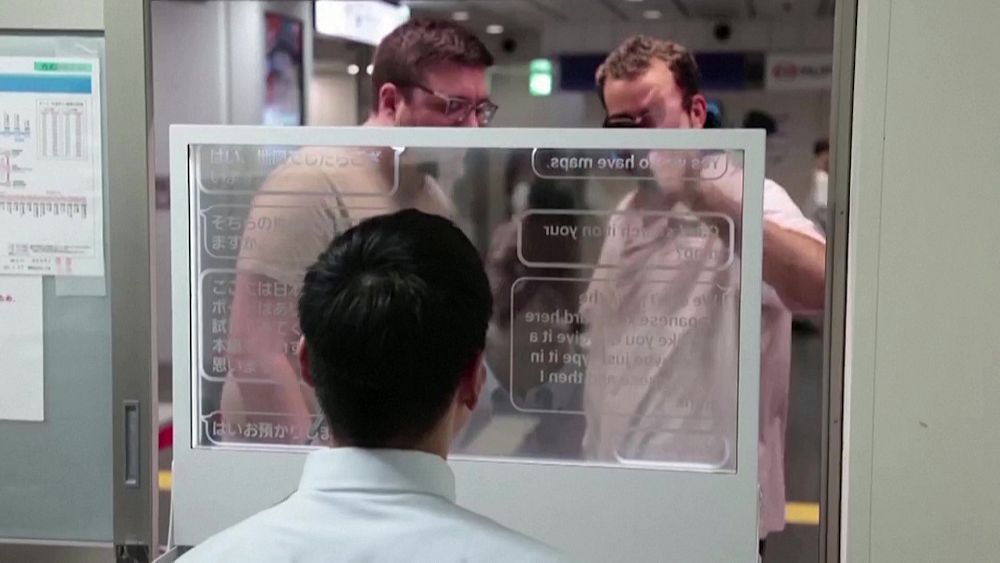A MEMORY. I’m fast asleep in the first room I’ve rented in Mexico City. I’m 23. I’ve been gathering my mettle after my first cataclysmic break-up, newly wading into the tide pools of hedonism and the shells that can slice your feet there. I’ve been comforted by the presence, secured by chance on the internet, of a gentle roommate and his great galumphing pewter-colored dog, Pechuga (“chicken breast,” if you must know). I’m jolted awake before dawn by a thunderous noise, the floorboards shuddering. Mexico City is a seismic zone and I’ll soon make the acquaintance of several earthquakes, but this is something else, I discover when I stumble out of bed and over to the window: it’s a brick wall, shoddily affixed to the facade of the building next door as an ornamental layer, that has collapsed in a single precipitous rush of matter, filling the passageway between the two buildings with debris.
I go downstairs and stand in the doorway. It’s barely light. At that moment, I see my roommate appear at the front gate, dazed and rumpled after a long night out, a baguette tucked under his arm, gaping at the felled wall that would have crushed him if he’d returned even a couple of minutes earlier. Within half an hour, police are picking their way over the rubble and a jaunty neighbor is distributing coffee in little glass cups. I’ve never witnessed an emergency more cheerful or less consequential. It’s a period in my life when most things feel unreal, in part because of how ferociously I want them to be real, to get realer, to keep going, to stay. I’m moved by how neatly the brick wall manages to translate itself into the space it’s been given. Not harming a soul.
¤
I started translating as an accidental overlap between two things I’d tried far more deliberately to learn about: poetry and the Spanish language. As a very young English-speaking person, it didn’t occur to me that my writing and reading lives might someday involve another language, too. And as a very young Spanish-learning person, what I wanted most desperately was to talk with other people; books had nothing to do with it. It wasn’t until a college semester in Buenos Aires that I made my first ungainly forays into translation. And it wasn’t until I moved to Mexico City a few years later that I began to view translation not just as a possible profession but as the form of both/and-ness I wanted for my entire life.
I’d tripped over poetry as a teenager, amid or despite whatever chirping, expository verselets I was fed at school. In poems, I came to find something I still seek there: an exacerbation of language in a way that both binds it to and releases it from everything else we use it for. Poetry didn’t feel linear, instrumental, or obedient. It wasn’t interested in small talk and didn’t appear to need it. It seemed to foster an intensity of being-alone, which I aspired to. What wasn’t to want? Adolescence is terrifying in part because of how easy it is to feel condemned by whatever you’re turning out to be like. Poetry helped me tap into something I knew I needed before I could trust it.
¤
As my daily life puttered along in English, Spanish flitted in the background that would eventually become a foreground, a language I had never heard spoken by the person who put it there: my paternal grandmother, Estela. Her parents left Mexico for the United States when she was a child, moving farther and farther north until they settled in Janesville, Wisconsin, of all places. When their friends and neighbors came calling, my great-grandparents would dress up the children in traditional suits and skirts and have them sing Mexican folk songs. A mini-pageant of mexicanidad for their new Midwestern fellows.
Estela, I’m told, was warm and spirited and had an almost Sleeping-Beauty-in-the-forest way with animals: the occasional hummingbird assented to alight on her palm. When her father forbade her from going to college, she ran away from home. Once married to my grandfather, Francis, a philosophy professor, she taught Spanish to would-be Peace Corps volunteers. She and Francis raised my dad and uncles in Denver, periodically road-tripping to Mexico to visit relatives and old family friends, dreaming of moving there together someday. But Francis died unexpectedly and young, and Estela waited to go back until what turned out to be her final years.
Most of what I know about my grandmother, who died years before my birth, is that she missed Mexico her entire life. She crooned in Spanish to the family dog, cursed him sweetly in the language her own parents had stopped speaking to anyone but each other.
My first real contact with this language transpired on a childhood trip to the city of Guanajuato, where Estela’s youngest brother Charlie had moved from Wisconsin on his retirement. I was nine. He lived in a house with a brick dome in the bedroom and a view of a hillside I’d peek at once I was supposed to be asleep. The dark slope glittered beguilingly, and dogs barked until late. In my mind, they’re connected now with an almost synesthetic sense of longing: the night’s flickering embroidery, the dogs calling out to each other. In the mornings came the scent of bleach from people scrubbing the sidewalks outside their homes and storefronts. It’s still one of my favorite smells, a preference for which I have no explanation but the early indecipherable prickle of wanting to know where I was.
Growing up without grandparents means, among other things, that you don’t get to witness your parents being someone else’s children, or receive your parents’ own origin stories from the people who told them first. I never experienced my grandmother’s nostalgia for Mexico, yet I experienced my father’s nostalgia for hers. As a kid, I was excited to visit a new country for the first time, but it was also thrilling to grasp that Mexico had something to do with my dad and therefore with me. He was suddenly different, equipped with brand new words. I envied him, yearned to join the deft, confident band of the bilingual, coveted the special power of becoming a whole person somewhere else. In other words, I wanted other words. A language you speak is the place you get to speak it in.
¤
I studied Spanish in middle school, then high school, as diligently I could manage. But diligence doesn’t get you far in the swerves and swoops of conversation. In college, fondling my depression like an amulet, I took some time off, then studied abroad for a semester in my junior year, partly because I wasn’t sure I’d finish otherwise. “Didn’t you
love it?” people would gush when I returned from my six months in Buenos Aires. I didn’t. The city felt aggressively lonely to me, or at least I was while in it. I shared an apartment with a married couple, a pair of cheerful, dreadlocked journalists who smoked a remarkable amount of weed while working nights for a Berlin-based newspaper, and a fourth person, a business student and devout Catholic. None of them could stand each other. One day, the pious business student moved out unannounced. Then the couple broke up and I was left alone with the grief-stricken husband, still a relative stranger to me, a housing arrangement I wouldn’t recommend to anyone for any length of time. Soon he too was gone.
I took long, grim walks, ate medialunas, craved strong condiments, avoided my apartment, and felt profoundly uncomfortable in the Spanish I’d come to speak, a mash-up of the Mexican cadence I clung to and the Argentine declarativeness that surrounded me now. Because I hadn’t really realized I had an accent in Spanish. I mean, of course I had one; everyone does when they speak anything. But it takes an act of displacement, not necessarily geographical though always social, to realize that the way you speak hearkens back to the place that taught you how. In Argentina, people asked me often about Mexico, hearing traces of it; some teased me about the lilt of my questions, a music I didn’t know I’d learned. This thrilled and consoled me: I missed Mexico, found Argentine Spanish indignant and shouty, often feared I’d put my foot in it without knowing why. When a professor urged me to adopt the swishy Argentine double-ll and y-sound—sho soy, está shoviendo—I resisted. I wanted to sound like the place I longed for.
¤
The problem with loving a place isn’t love but reciprocity. It’s easy to love with your senses, to thrill at the sensation of being swept up in something enormous, a tiny cog in a vast and beautiful wheel. It’s easy to marvel at the mountains in the distance, occasionally visible through the smog from the valley they once cleaved. Their nearness is a solace. You could get there if you wanted to. But you don’t want to: you want to be here, in the middle of the human swirl, swallowed up. You hear yourself say it: I love this place. Which doesn’t have to love you back.
In the years after I moved to Mexico City in 2011, I lived with roommates (eight? 10?) a partner (twice), and several animals (always cats, except for Pechuga). I briefly rented a room from an ancient woman who kept a canary named Fernando and distrusted The Simpsons (“I hate those monsters,” she’d mutter when they came on TV). Only once, for a few months before the start of the pandemic, did I live alone. I was proud of my repeated relocations even as I wearied of them. I liked learning the rhythms of different neighborhoods, the dense, erratic punctuation along an unfamiliar block: the crazy clang of the brass bell rung by the garbage collectors on their beat; Doppler-effected snippets of salsas, rancheras, reguetón; the polyphony of markets; the prerecorded proclamations of vendors passing slowly in their pickup trucks or tricycle carts, selling fruit or bread or tamales oaxaqueños. And yet, in ways that are dawning on me only now, I’ve generally been more engrossed in this amorous observation than in actively assembling my own domestic space. My decision to live in this particular city felt as permanent as anything I’d ever ventured upon, but I rarely put much of anything up on my own particular wall.
Twelve years later, I’m trying to loosen my grip on my own desire for permanence. But I feel these years in me, and sometimes I find myself searching for tangible evidence of them. Not the passive love of place, but the enmeshments born of it. The changes in my habits, syntax, sense of humor; the way I greet a stranger. Where I find them—the proof of my own minor transmutations at the hands of this city—is in my accent, my friends, and the poems I’ve translated, some written by those friends themselves.
¤
As a college student in Buenos Aires, I took a translation workshop with Ezequiel Zaidenwerg, a poet and translator only a few years older than I was. He turned out to be militant about poetic meter, which was not something I’d learned anything about in the English-language tradition that was ostensibly my major. The mechanics came as an unpleasant shock. For our first creative assignment, he urged us to translate a poem within a set of metrical constraints. I was baffled. Worse, I wasn’t any good at it. And I was vexed, in an entitled sort of way, to feel what I’d come to identify as my only real aptitude being squashed by some neurotic fixation on form.
I hacked my way through a long sequence of dismal translations during the weeks that followed, continued my strange trudges through the city, and ran into my last remaining roommate outside our building, trying to rip apart his wife’s wedding veil with his bare hands. The trees I hadn’t noticed when I arrived, in the winter of another hemisphere, burst into yellow blossoms in the spring and slicked the sidewalks.
The click came eventually. I first felt it with a Lorca poem: the rush of affinity I was already familiar with as a reader of poems—this!—plus the satisfaction of fitting a puzzle piece into place. I felt myself slip into something that was already there—something with a shape, a voice, a gait, a history, a wake trailing behind it—and try to move around inside.
Ezequiel’s exhortations about meter had something of an old adage: needing to learn the rules before you break them and so on. It strikes me now, though, that even as a bona fide baby poetry nerd, I’d still been conditioned to associate poetic form with punishment, or at least with regiment. It hadn’t occurred to me that such “rules” were also resources: tools to explore and experiment with, a well to plumb, an invitation to suppleness in perpetual exercise. And in urging me to translate metrically, Ezequiel was mostly just urging me to practice thinking about both parts and wholes, and about how translation must attend to both.
¤
Parts and wholes. The whole is the place. The parts are the people fluttering around in it, speaking to each other in slang that ages and changes as they do, buying cups of sliced mango speckled with tajín, forgetting their umbrellas, burying their mothers, getting fired from their jobs, groaning hungover, deciding to have children, resolving not to, overhearing snippets of ominous news on the radio, mistaking the blare of an 18-wheeler for the earthquake alarm, writing poems about the unseen histories of the ground they tread.
Mexico City: it’s one of the biggest in the world. It used to be a lake. It’s flanked by volcanoes, but the air is so smog-marred that they’re often invisible. Entire neighborhoods, including one of the richest, were built over or with or through ancient lava formations. The volcanic rock still simmers motionless through contemporary life. Tamed with loam, gardened into affluence. Over time, the atmospheric transformations dictated by money and dominion have drained, plugged, or fatally sullied countless rivers that once ran through the city. Through what the city is now. I think of them wistfully, have translated poems about them, still can’t imagine them, not really.
That’s the feeling I have when I think of this city I love so much. I love it and yet it escapes my imagination. Over and over, I’ve tried to find my way into it through poems. Poems by Javier Peñalosa about the missing rivers themselves, and about a mysterious band of travelers who set out in search of the water they lost—a search that also evokes the stark contemporary reality of Mexico’s forcibly disappeared people, numbering in the hundreds of thousands. Poems by Maricela Guerrero on learning to observe and classify local plants; on the imperial lexicon that governs systems of classification in the first place; on how to be part of the natural world that is the world even here, in a city of 23 million residents and their corresponding cement. Sharp-edged, lurching poems by Juana Adcock that explore the unfathomability of violence and the disparate political implications of Spanish and English. Poems and more poems by poets whose work may not be centered thematically on Mexico but who wrote here, and whom I got to know here; whose syntax as poets nourished and accompanied the changes wrought to my two languages as I continued to live in both.
I’ve felt these changes as I speak, but also as I write and translate. It’s here, after all, that the exercises of translation, writing, and friendship feel inextricable to me. Soon after I moved to Mexico City, I met several young poets who with virtuosic playfulness unlatched me after many months when I’d struggled to write at all. Their poems were irreverent and improvisatory, caustic, crackling, rich with consonance and slant rhymes. As I emerged, timorous, from an inner gridlock, these new friends’ freewheeling poems returned me to the tactile pleasures—and the messiness—of language. The swoops and shapeliness of their Spanish somehow gave me permission, or helped me give myself permission, to explore sound more brashly in my English; to start there and see where it went, even if I wasn’t entirely sure of what I had to say. They helped me translate something into my poems: a desire, a sense of possibility, a reveling.
Even “solitary” art is never made alone, and the language we use to write or translate is the stuff of the speech we share. The sounds we make with our mouths and receive with our ears. The gasps, the laughter.
¤
When people talk about the original versus a translation, there’s a general consensus that “original” refers to the text in the language of origin: the very first iteration of a text that is then translated into (derived from) the previous. Yet the accompanying assumption is that the first version to be written is also the first to be published. I write in English, but my poems thus far have lived their small public lives primarily in Spanish—thanks to my old friend Ezequiel, their translator. If my life is a bilingual one, theirs is more so. His translations are the original, in a way: they are quicker to show their face.
I feel this slipperiness, this porousness most intensely at poetry readings. For the first several years I lived in Mexico, I felt a little rift between the humming intensity of reading my poems aloud in English and the hesitancy of reading Ezequiel’s Spanish versions. In English, I could internalize what I’d written in a way that allowed me to actually perform it. In Spanish, though, I felt an alarming proximity between the translated words and myself, as if I’d accidentally sidled up too close, invaded their personal space. I had to focus my eyes and train my lips to do anything more than recite what the lines simply said. For a long time, I would read in English and ask someone else to join me for the Spanish.
At some point, though, I shifted to reading almost entirely in Spanish—which meant opening myself and my poems to the differing intimacies of my two languages, warts and all. Not that they’re mine. In reading someone else’s translations aloud not as if they were mine, but in acknowledging that they are not, I have the honor of sharing their work as much or more than my own. It’s their words I’ve taken into myself, their words I release. It may be obvious, this fact and what it has to say about translation, whether you are the translator or the translated, but I’m always moved to remember it: it’s never just about you. It’s never just you at all.
¤
A person’s life can always be otherwise. Migration brings this truism to light—to life—with singular starkness. You know it’s true because your life was otherwise. Now it’s
this, reconfigured, transposed. Translated. You could change again. You do.
I’ve lived in Mexico City long enough to witness the ends of many relationships, including my own; to see friends lose friends and parents and mentors; to realize that none of the spots I frequented in the first neighborhood I lived in even exist anymore. Long enough to forget what some of them were called. Not long enough to know what the city was like before the infamous earthquake that would forever give my first roommate’s mother a panic attack every time the ground began to undulate underfoot, the hanging lamps ducking their heads like dandelions. Not long enough to know if I could still call it home if I ever left.
Some days, when I catch myself wondering what it means to belong, or be rooted, or have a home at all; when I feel simultaneously stricken and captivated by the rhythms of loss and renewal that jostle even the bonds that seem most certain, most secure; when I feel weighed down by books, or, alternatively, appalled by how easy it can be to pack them up and put them away, I think about all the poems I’ve ever heard someone read aloud in Mexico City. In bars and conference rooms and public parks and the living rooms of strangers, sitting on the floor and drinking warm beer. And the poems I dog-eared in books, and the poems someone pushed across a table to me with a sense of shy, conspiratorial joy, and the poems I translated because they were already working their way through my bloodstream, right where I wanted them.
They, and the city I’ve lived in, longed to stay in, and still yearn to truly see, make me think of a remark by Don Mee Choi: “The poems have to live inside us and they are changed by being inside our bodies.” I feel changed by having them inside my body. I take them with me, treading as lightly as I can across this metropolis, on the days when the clouds and smog disperse enough for a glimpse of the volcanoes in the distance, and on the other days when you might forget they’re here. Always have been.
¤
Robin Myers is a poet and translator whose work received a 2023 NEA Translation Fellowship and was included in the 2022 Best American Poetry
anthology.
Adblock test (Why?)












